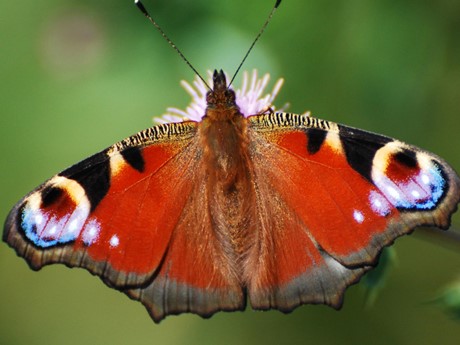When do wood anemones start flowering?
Judith Garforth, 22/03/2021
Wood anemone flowers are beautiful, symbolic and ancient woodland indicators. One of the earliest spring blooms, their flowering times have been recorded for hundreds of years. Here’s a summary of what we already know about their phenology, but we need your help to continue this important biological record into the next decade and beyond.
If you spot a wood anemone plant flowering this year please record the date on the Nature’s Calendar website to help scientists investigate how weather and climate are affecting their flowering time.
What do wood anemones look like?
Part of the buttercup family, the pretty star-like flowers of wood anemone (Anemone nemorosa) are easily recognisable. They have 6 or more white sepals (that look like petals), sometimes flushed pink or purple, and one flower per stem. The flowers open in the sunshine but close on cloudy days. A whorl of 3 palmately-lobed leaves is found halfway up their stem as well as leaves on longer stalks growing from their root.
They usually start to flower from March to April and are often found in deciduous woodlands, old hedgerows, under bracken and in upland meadows. Don’t confuse them with wood-sorrel plants which have trefoil shaped leaves like clover.
Wood anemones spread slowly via underground rhizomes (creeping underground stems), making them a good ancient woodland indicator species. Ancient woodlands cover only 2.4 % of the UK and are areas of woodland that have persisted since 1600 in England and Wales, and 1750 in Scotland. With centuries of undisturbed soils and accumulated decaying wood they provide a unique and irreplaceable habitat for fungi and invertebrates.

Wood anemone flower with 6 white sepals (Photo: Robert Read)

A carpet of wood anemones in a deciduous woodland (Photo: WTPL)
How to add a record to Nature’s Calendar
The Nature’s Calendar project tracks the effects of weather and climate change on 69 wildlife species across the UK – its records date all the way back to 1736! By taking just a few minutes to share what you see, you'll be adding to hundreds of years' worth of important data.
First find a wood anemone plant that you can keep an eye on this spring. When the first flower head starts to open up (when you can see inside it) make a note of the date and add a record of wood anemone ‘first flowering’ on our website. You can upload a photo too. Your record will go instantly into the Nature’s Calendar database to be used by scientists for research. You can view your record on the map and see where and when wood anemones have been spotted across the UK so far this spring.
Where to find wood anemones
If you want to find some wood anemones to record this year, Woodland Trust woods have public access and are free to visit. Here are a selection of our woods, around the UK, that we know have gorgeous displays of wood anemones:
- Londonthorpe Woods (Lincolnshire)
- Skipton Castle Woods (Yorkshire)
- Parc Mawr (Conwy Valley, Wales)
- Drumnaph Wood (County Londonderry, Northern Ireland)
- Glen Finglas (Stirling, Scotland)
You can also search by postcode to find your nearest wood.

Wood anemones at Skipton Castle Woods 2019 (Photo: Lorienne Whittle)

Wood anemone flower and whorl of 3 leaves (Photo: Lorienne Whittle)
Wood anemone phenology – when do wood anemones start flowering?
Phenology is the study of seasonal changes in plants and animals from year to year, such as flowering of plants, emergence of insects and migration of birds, especially their timing and relationship with weather and climate. The flowering of wood anemone plants has been recorded for hundreds of years so we know that they normally start to flower in the UK from March to April.
Robert Marsham was Britain's first phenologist and recorded 27 'Indications of Spring', on his estate in Norfolk, between 1736 and his death in 1797. One of these 27 indications was the earliest date of wood anemone flowering each year, which he started recording in 1761. After his death, his family continued recording the indications of spring until 1958. These records have been analysed and a relationship has been found between early spring temperature and flowering date (flowering is earlier in warmer springs).
Wood anemone flowering was also included in the phenology recording scheme run by the Royal Meteorological Society (RMS) between 1875-1947, and so in order to continue these historic records it was selected as a recording event for the Nature’s Calendar phenology project too. These more recent wood anemone data sets have also been analysed and similarly it has been found that wood anemone plants respond to increasing temperatures by advancing their flowering dates.

Wood anemone first flowering 08/04/19 (Photo: Mary Kerby)

Wood anemone and lesser celandine 23/03/19 (Photo: Kayleigh Williams)

Wood anemone fully open 18/03/19 (Kay Shaw)
Wood anemones are woodland understorey species and so they need to make use of the available light in the early spring before the trees develop their leaves and create too much shade. A phenology project called ‘Track a Tree’ ran from 2013-2015 to investigate the spring phenology of woodland trees and the associated flowers growing beneath them. Analysis of this data found that peak flowering of wood anemone was approximately 22 days earlier than date of oak first leaf.
These historic records show us when wood anemone has flowered in the past, but it’s also interesting to predict what will happen in the future as our climate changes. Scientists at the University of Edinburgh used Nature’s Calendar records to explore whether plants will continue to leaf or flower at the best time for growth (also known as the optimum phenology) as temperatures rise in the future. It was concluded that wood anemone is likely to be able to keep up with changes in their optimum timing.
